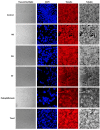Phenolic Compounds Isolated from Caesalpinia coriaria Induce S and G2/M Phase Cell Cycle Arrest Differentially and Trigger Cell Death by Interfering with Microtubule Dynamics in Cancer Cell Lines
- PMID: 28441723
- PMCID: PMC6154320
- DOI: 10.3390/molecules22040666
Phenolic Compounds Isolated from Caesalpinia coriaria Induce S and G2/M Phase Cell Cycle Arrest Differentially and Trigger Cell Death by Interfering with Microtubule Dynamics in Cancer Cell Lines
Abstract
Caesalpinia coriaria (C. coriaria), also named cascalote, has been known traditionally in México for having cicatrizing and inflammatory properties. Phytochemical reports on Caesalpinia species have identified a high content of phenolic compounds and shown antineoplastic effects against cancer cells. The aim of this study was to isolate and identify the active compounds of a water:acetone:ethanol (WAE) extract of C. coriaria pods and characterize their cytotoxic effect and cell death induction in different cancer cell lines. The compounds isolated and identified by chromatography and spectroscopic analysis were stigmasterol, ethyl gallate and gallic acid. Cytotoxic assays on cancer cells showed different ranges of activities. A differential effect on cell cycle progression was observed by flow cytometry. In particular, ethyl gallate and tannic acid induced G2/M phase cell cycle arrest and showed interesting effect on microtubule stabilization in Hep3B cells observed by immunofluorescence. The induction of apoptosis was characterized by morphological characteristic changes, and was supported by increases in the ratio of Bax/Bcl-2 expression and activation of caspase 3/7. This work constitutes the first phytochemical and cytotoxic study of C. coriaria and showed the action of its phenolic constituents on cell cycle, cell death and microtubules organization.
Keywords: Caesalpinia coriaria; apoptosis; cancer; cell cycle; cell death; ethyl gallate; gallic acid; microtubules; phenolic compounds; tannic acid.
Conflict of interest statement
The authors declare no conflict of interests.
Figures







Similar articles
-
Antibacterial activity of compounds isolated from Caesalpinia coriaria (Jacq) Willd against important bacteria in public health.Microb Pathog. 2019 Nov;136:103660. doi: 10.1016/j.micpath.2019.103660. Epub 2019 Aug 6. Microb Pathog. 2019. PMID: 31398533
-
Galloyl derivatives from Caesalpinia coriaria exhibit in vitro ovicidal activity against cattle gastrointestinal parasitic nematodes.Exp Parasitol. 2019 May;200:16-23. doi: 10.1016/j.exppara.2019.03.012. Epub 2019 Mar 23. Exp Parasitol. 2019. PMID: 30914262
-
Gastroprotective effect methanol extract of Caesalpinia coriaria pods against indomethacin- and ethanol-induced gastric lesions in Wistar rats.J Ethnopharmacol. 2023 Apr 6;305:116057. doi: 10.1016/j.jep.2022.116057. Epub 2022 Dec 24. J Ethnopharmacol. 2023. PMID: 36574790
-
Apoptosis-inducing Plant-based Phenolic Compounds are Effective on Leukemia Cell Lines.Curr Pharm Des. 2023;29(14):1092-1104. doi: 10.2174/1381612829666230417110032. Curr Pharm Des. 2023. PMID: 37070446 Review.
-
Therapeutic Potential of Plant Phenolic Acids in the Treatment of Cancer.Biomolecules. 2020 Feb 3;10(2):221. doi: 10.3390/biom10020221. Biomolecules. 2020. PMID: 32028623 Free PMC article. Review.
Cited by
-
Enhancing Giardicidal Activity and Aqueous Solubility through the Development of "RetroABZ", a Regioisomer of Albendazole: In Vitro, In Vivo, and In Silico Studies.Int J Mol Sci. 2023 Oct 6;24(19):14949. doi: 10.3390/ijms241914949. Int J Mol Sci. 2023. PMID: 37834396 Free PMC article.
-
Association between dietary carrot intake and breast cancer: A meta-analysis.Medicine (Baltimore). 2018 Sep;97(37):e12164. doi: 10.1097/MD.0000000000012164. Medicine (Baltimore). 2018. PMID: 30212943 Free PMC article.
-
Deciphering the mechanism of PSORI-CM02 in suppressing keratinocyte proliferation through the mTOR/HK2/glycolysis axis.Front Pharmacol. 2023 Apr 7;14:1152347. doi: 10.3389/fphar.2023.1152347. eCollection 2023. Front Pharmacol. 2023. PMID: 37089953 Free PMC article.
-
Potential of Thai Herbal Extracts on Lung Cancer Treatment by Inducing Apoptosis and Synergizing Chemotherapy.Molecules. 2020 Jan 6;25(1):231. doi: 10.3390/molecules25010231. Molecules. 2020. PMID: 31935933 Free PMC article.
-
Chemical Constituents with GNMT-Promoter-Enhancing and NRF2-Reduction Activities from Taiwan Agarwood Excoecaria formosana.Molecules. 2020 Apr 10;25(7):1746. doi: 10.3390/molecules25071746. Molecules. 2020. PMID: 32290267 Free PMC article.
References
-
- Saracci R., Wild C.P. International Agency for Research on Cancer: The First 50 Years, 1965–2015. IARC Press; Albany, NY, USA: 2015.
-
- Soto Nunez J.C., Sousa M.S. Plantas Medicinales de la Cuenca del Rio Balsas. Universidad Nacional Autonoma de Mexico; Distrito Federal, Mexico: 1995. pp. 7–198. No. 25.
MeSH terms
Substances
LinkOut - more resources
Full Text Sources
Other Literature Sources
Research Materials

